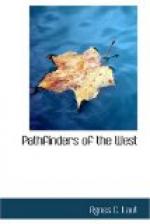The Great Beyond held the two things most coveted by ambitious young men of New France,—quick wealth by means of the fur trade and the immortal fame of being a first explorer. Nicolet had gone only as far as Green Bay and Fox River; Jogues not far beyond the Sault. What secrets lay in the Great Unknown? Year after year young Frenchmen, fired with the zeal of the explorer, joined wandering tribes of Algonquins going up the Ottawa, in the hope of being taken beyond the Sault. In August, 1656, there came from Green Bay two young Frenchmen with fifty canoes of Algonquins, who told of far-distant waters called Lake “Ouinipeg,” and tribes of wandering hunters called “Christinos” (Crees), who spent their winters in a land bare of trees (the prairie), and their summers on the North Sea (Hudson’s Bay). They also told of other tribes, who were great warriors, living to the south,—these were the Sioux. But the two Frenchmen had not gone beyond the Great Lakes.[2] These Algonquins were received at Chateau St. Louis, Quebec, with pompous firing of cannon and other demonstrations of welcome. So eager were the French to take possession of the new land that thirty young men equipped themselves to go back with the Indians; and the Jesuits sent out two priests, Leonard Gareau and Gabriel Dreuillettes, with a lay helper, Louis Boesme. The sixty canoes left Quebec with more firing of guns for a God-speed; but at Lake St. Peter the Mohawks ambushed the flotilla. The enterprise of exploring the Great Beyond was abandoned by all the French but two. Gareau, who was mortally wounded on the Ottawa, probably by a Frenchman or renegade hunter, died at Montreal; and Dreuillettes did not go farther than Lake Nipissing. Here, Dreuillettes learned much of the Unknown from an old Nipissing chief. He heard of six overland routes to the bay of the North, whence came such store of peltry.[3] He, too, like the two Frenchmen from Green Bay, heard of wandering tribes who had no settled lodge like the Hurons and Iroquois, but lived by the chase,—Crees and Sioux and Assiniboines of the prairie, at constant war round a lake called “Ouinipegouek.”
[Illustration: A Cree brave, with the wampum string.]
By one of those curious coincidences of destiny which mark the lives of nations and men, the young Frenchman who had gone with the Jesuit, Dreuillettes, to Lake Nipissing when the other Frenchmen turned back, was Medard Chouart Groseillers, the fur trader married to Radisson’s widowed sister, Marguerite.[4]
When Radisson came back from Onondaga, he found his brother-in-law, Groseillers, at Three Rivers, with ambitious designs of exploration in the unknown land of which he had heard at Green Bay and on Lake Nipissing. Jacques Cartier had discovered only one great river, had laid the foundations of only one small province; Champlain had only made the circuit of the St. Lawrence, the Ottawa, and the Great Lakes; but here was a country—if the Indians spoke the truth—greater than all the empires of Europe together, a country bounded only by three great seas, the Sea of the North, the Sea of the South, and the Sea of Japan, a country so vast as to stagger the utmost conception of little New France.




